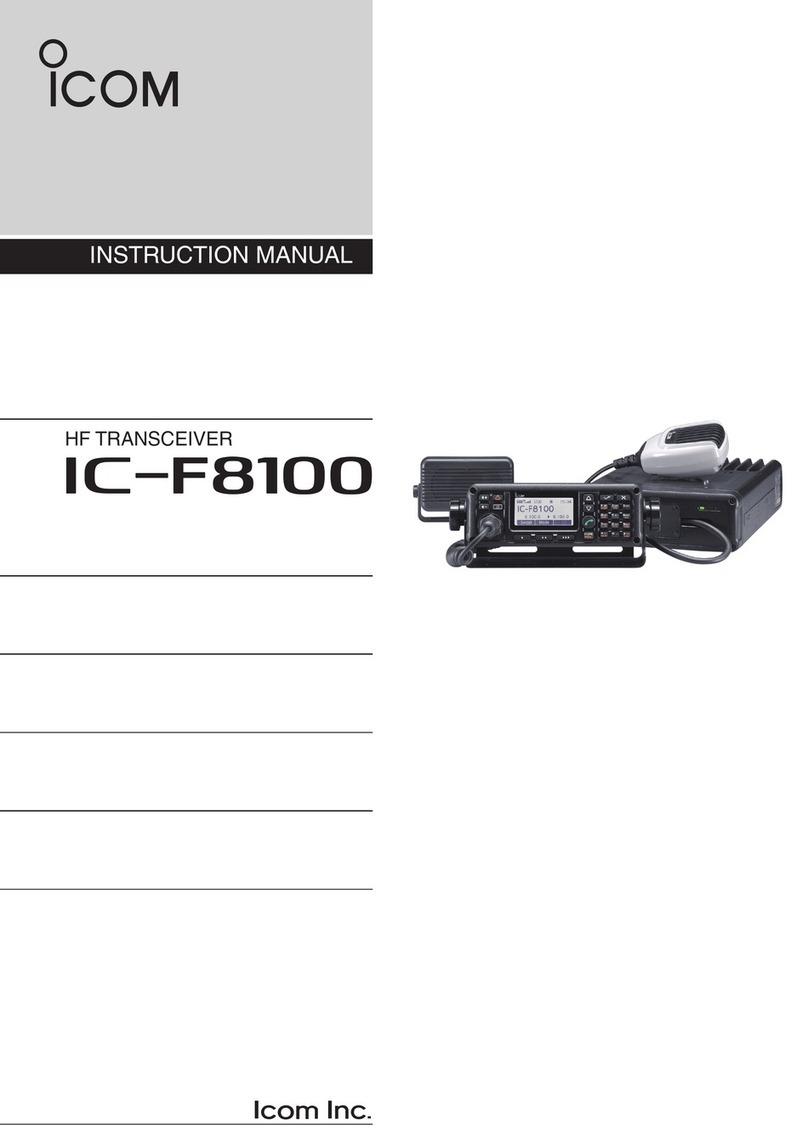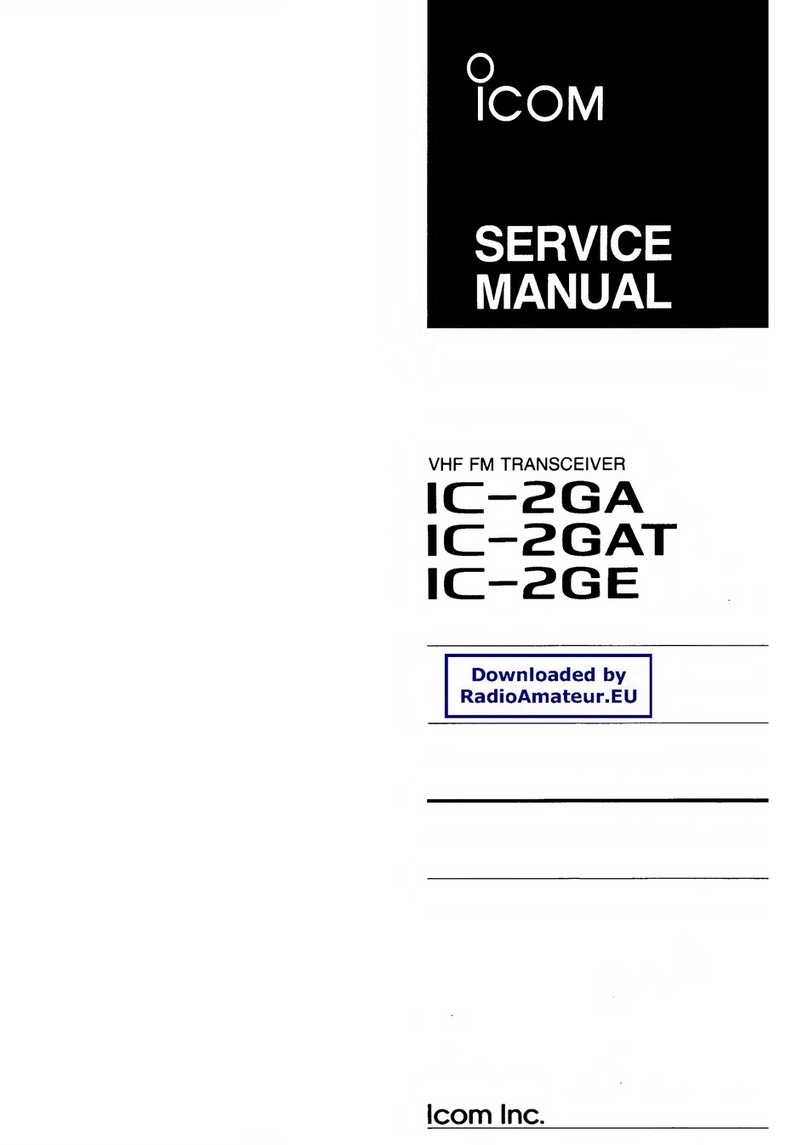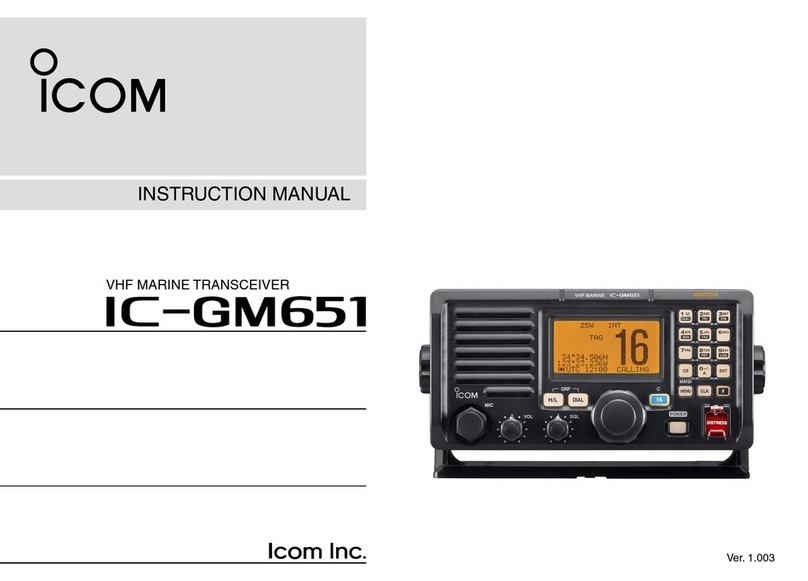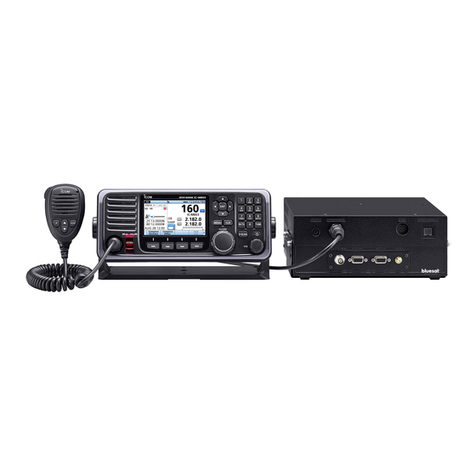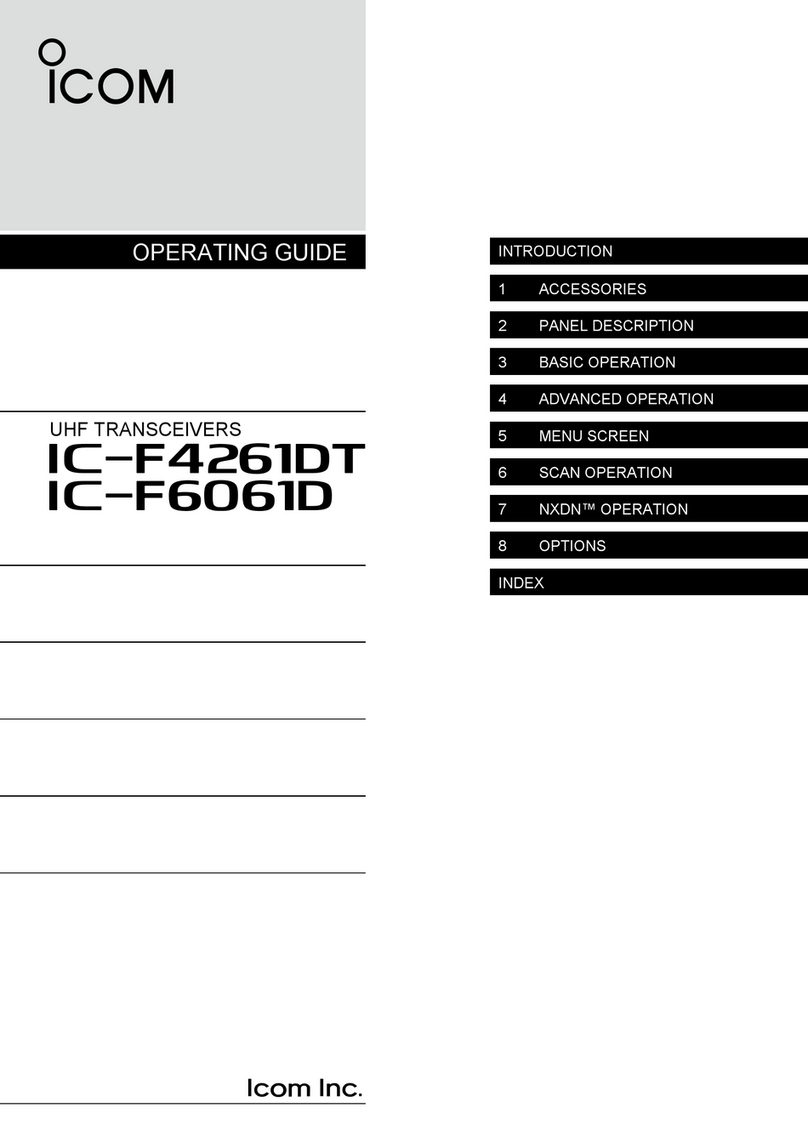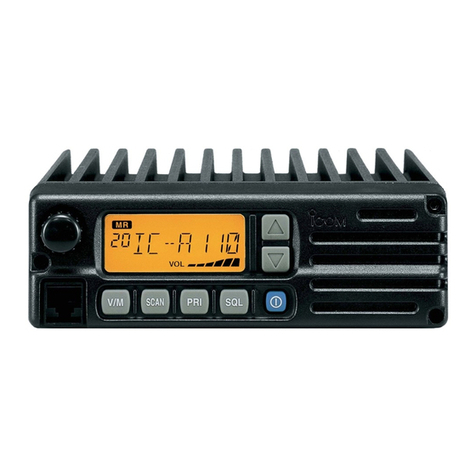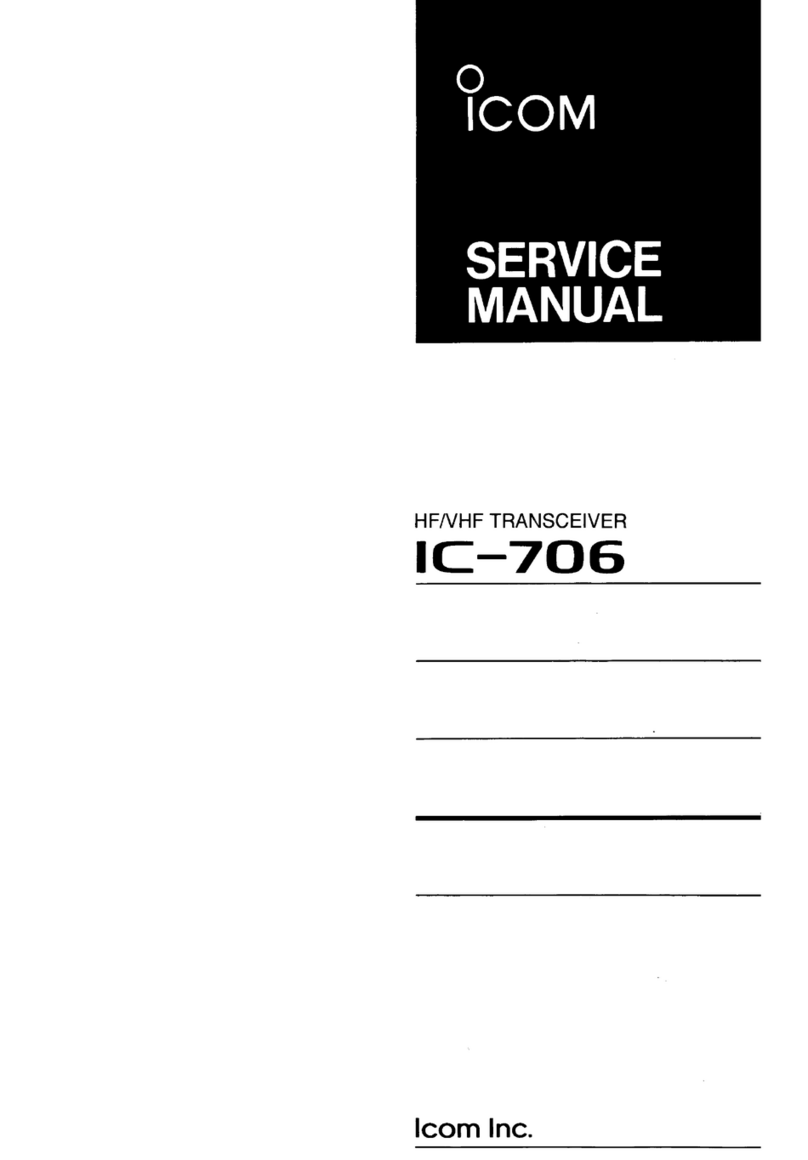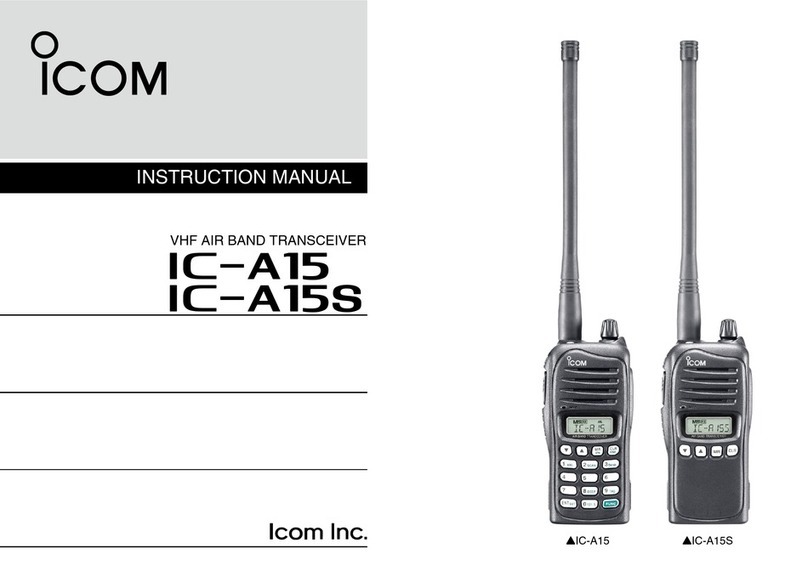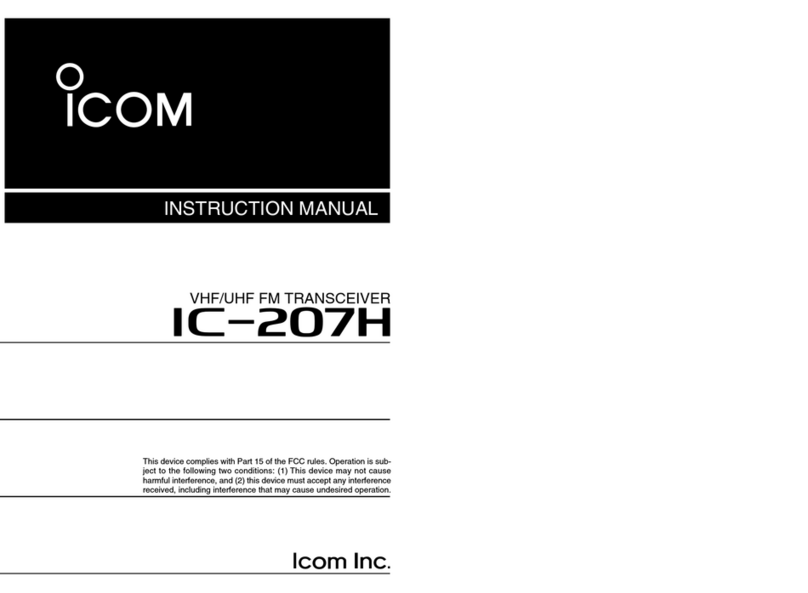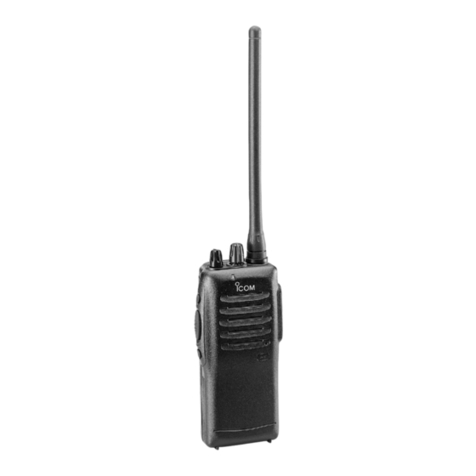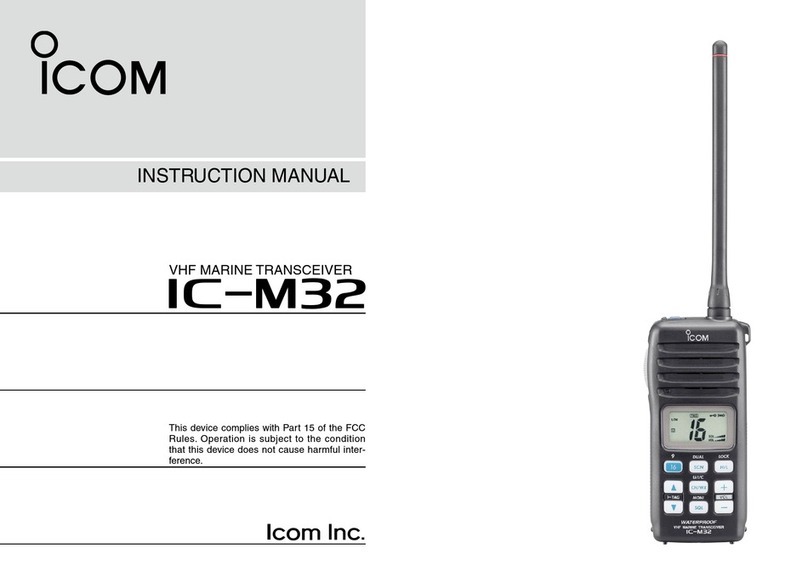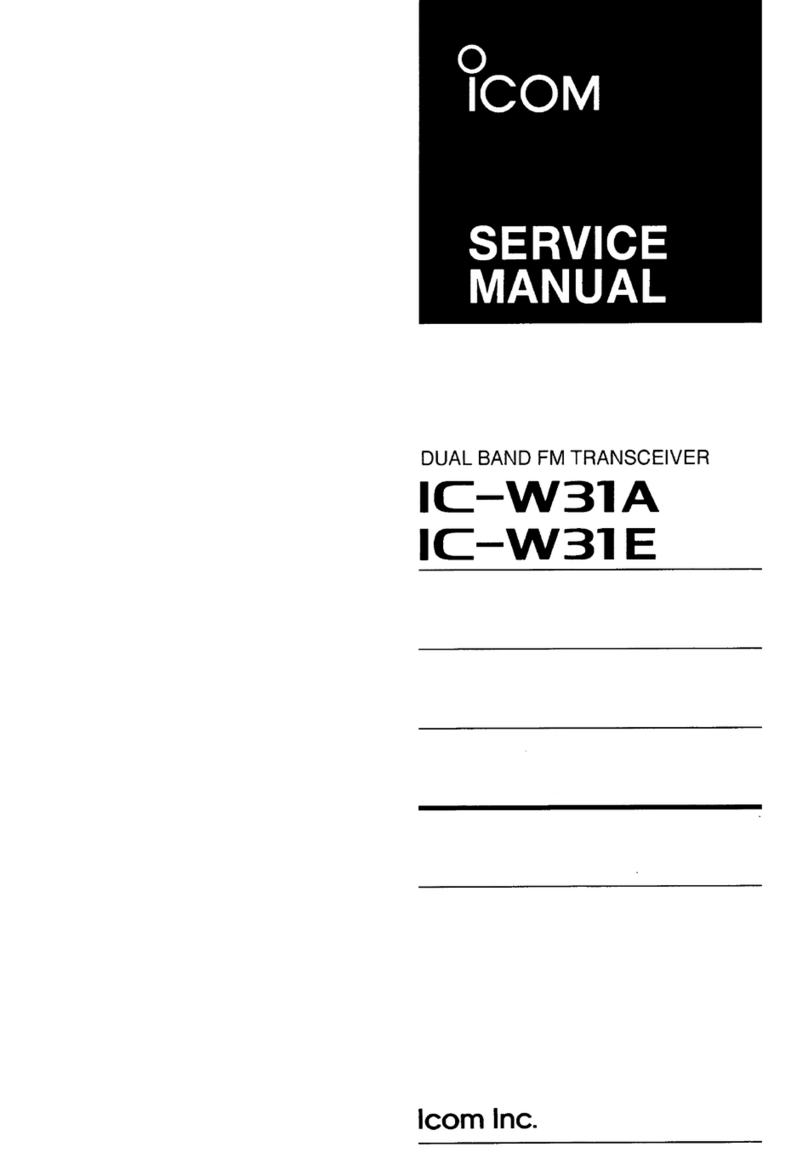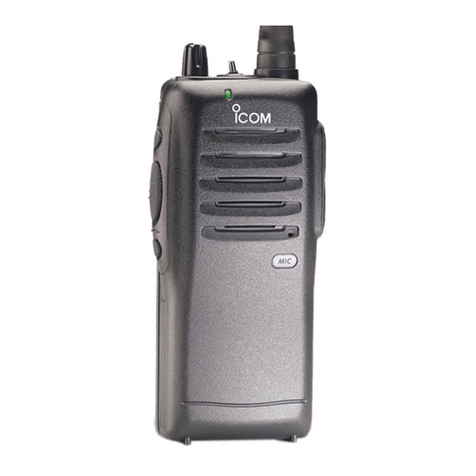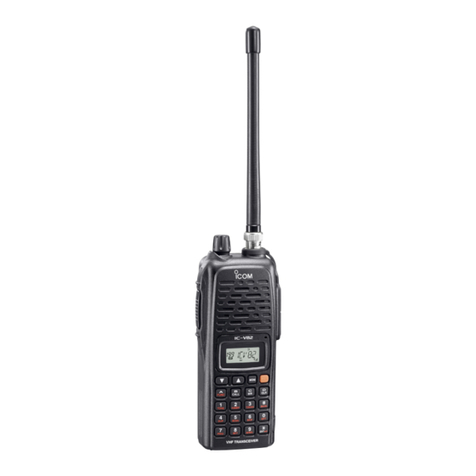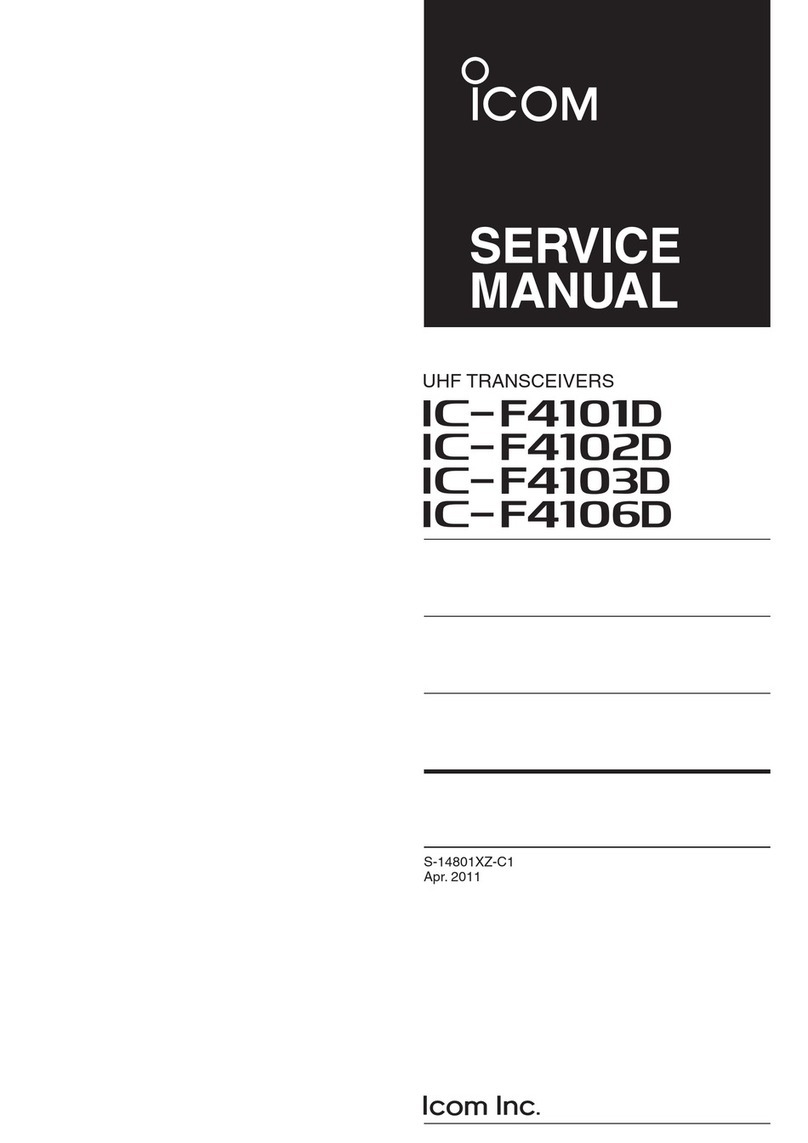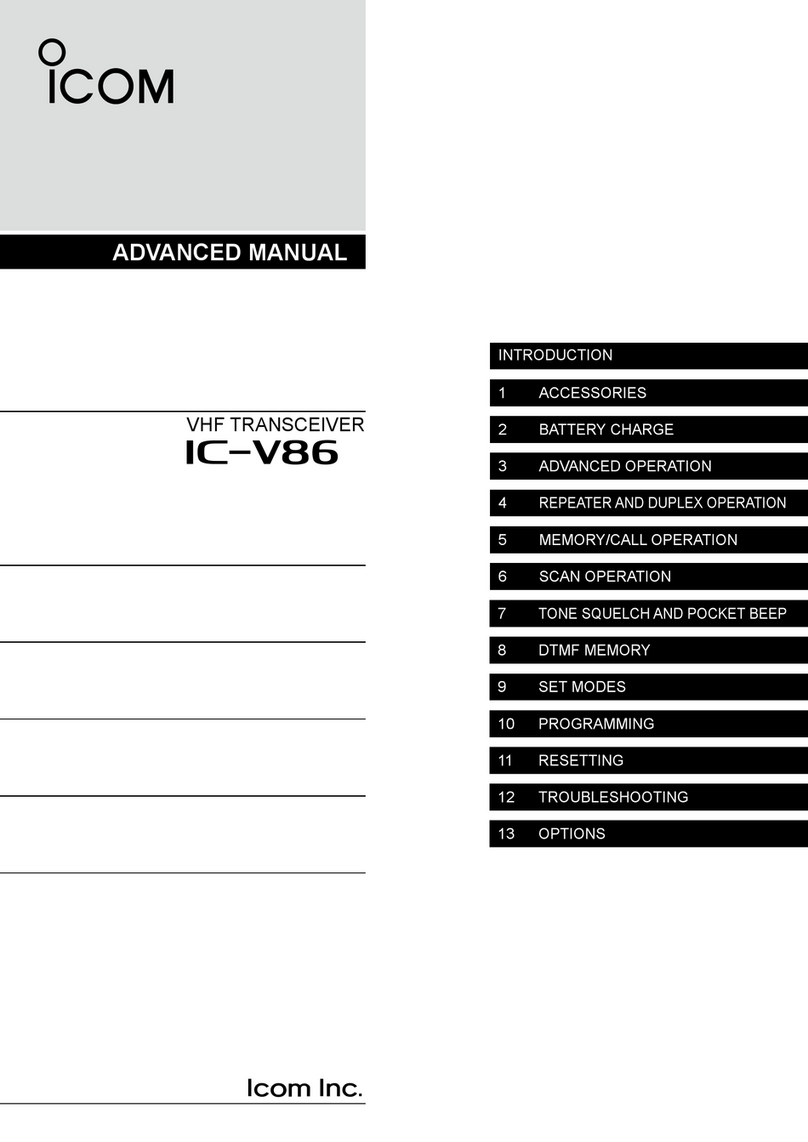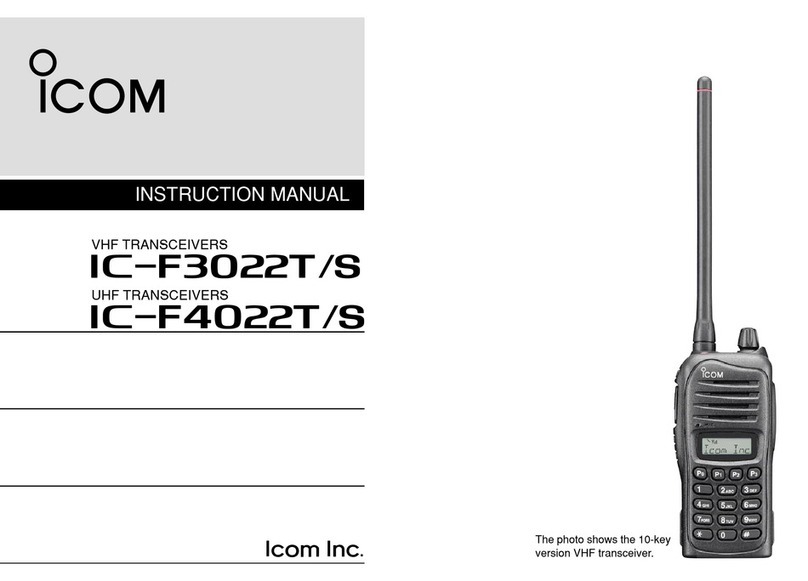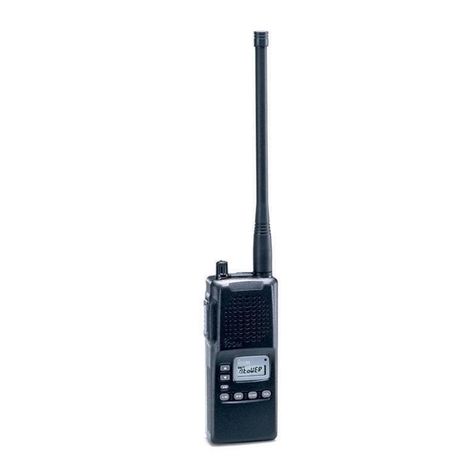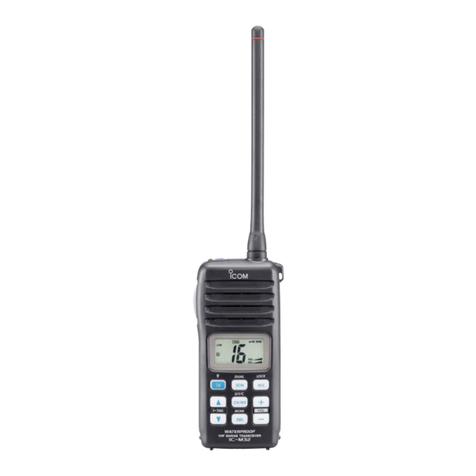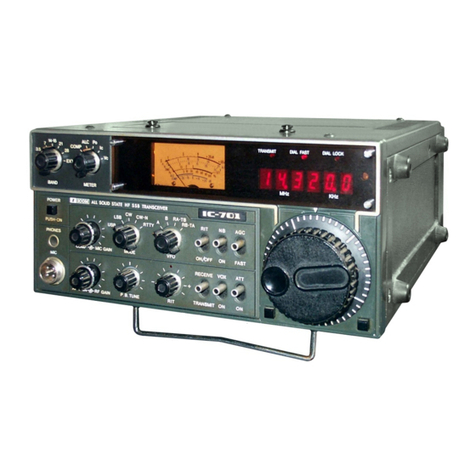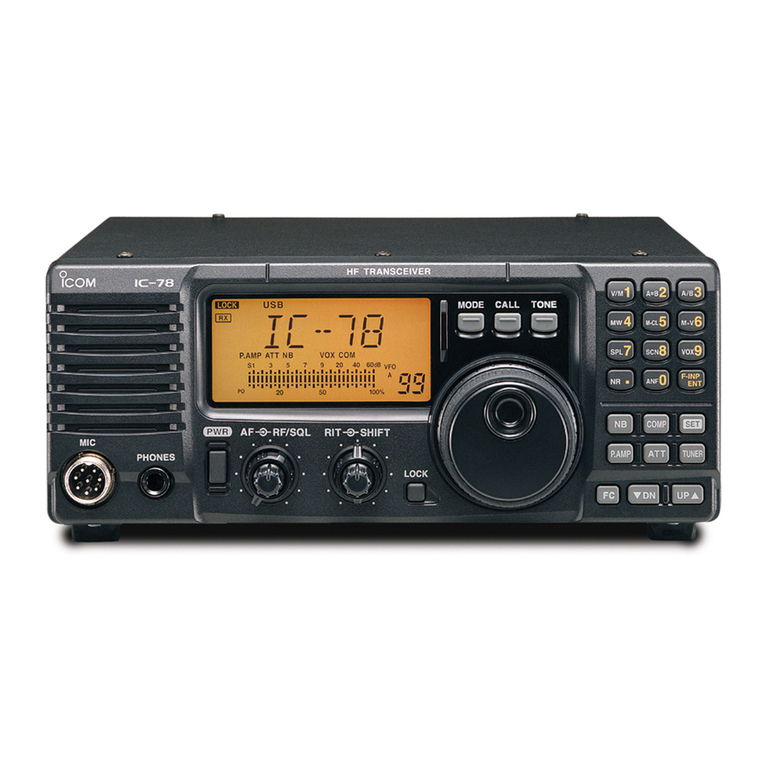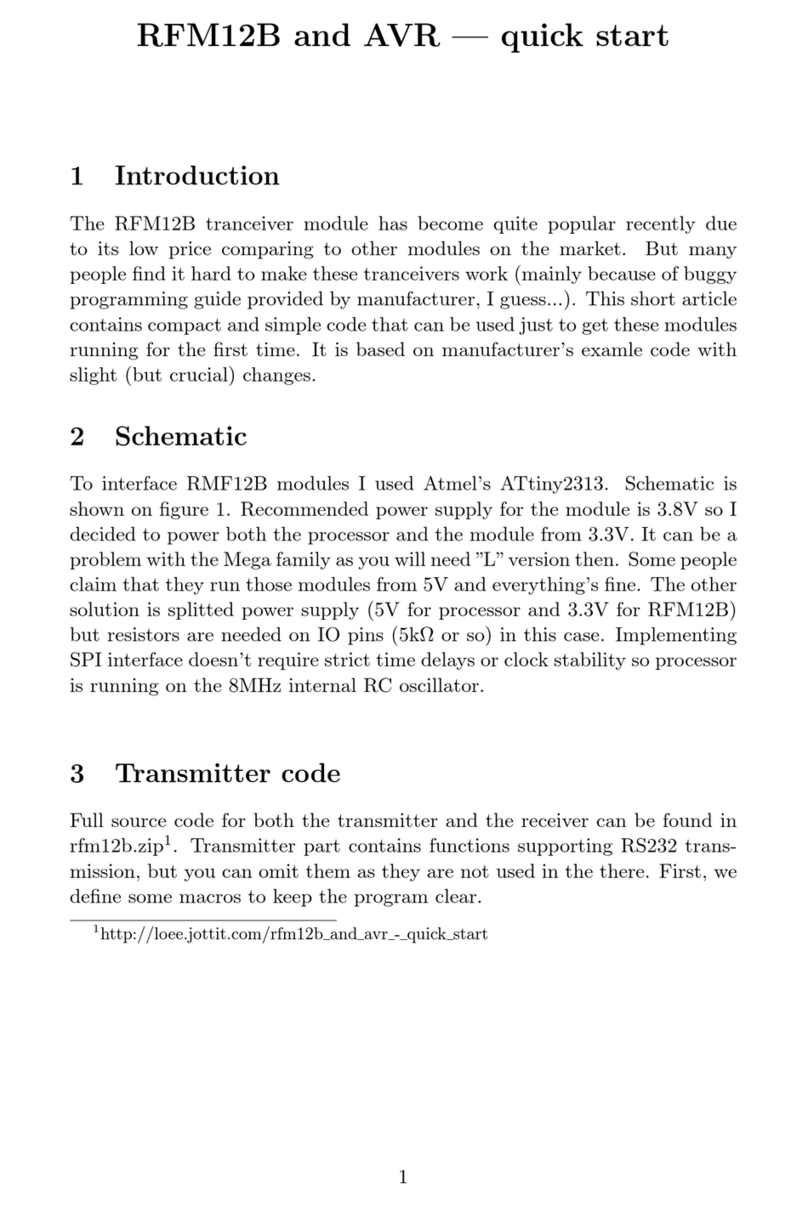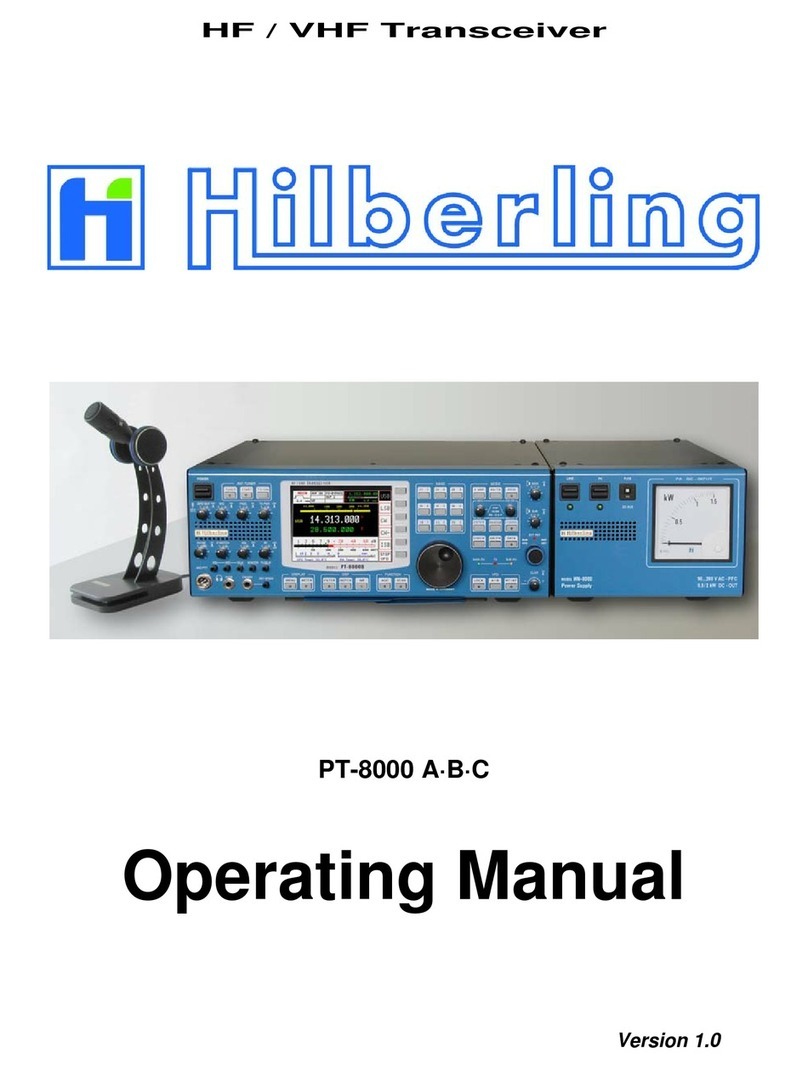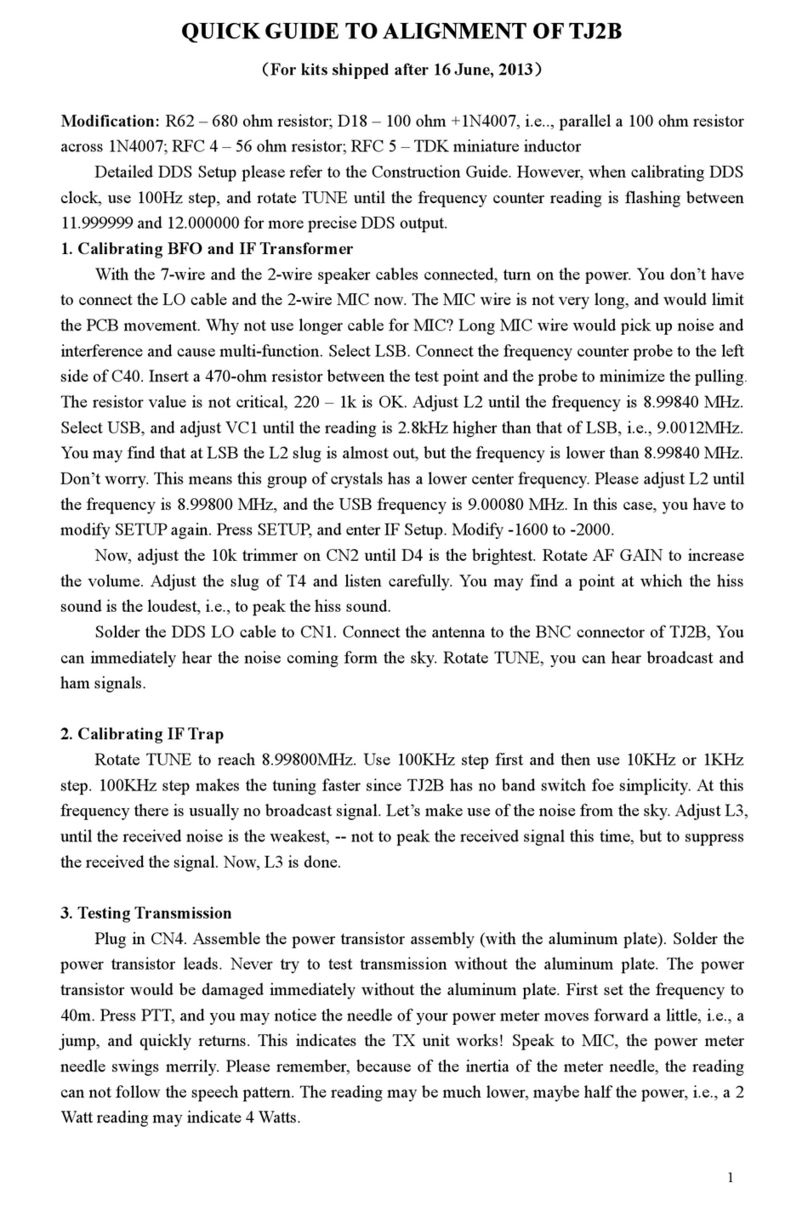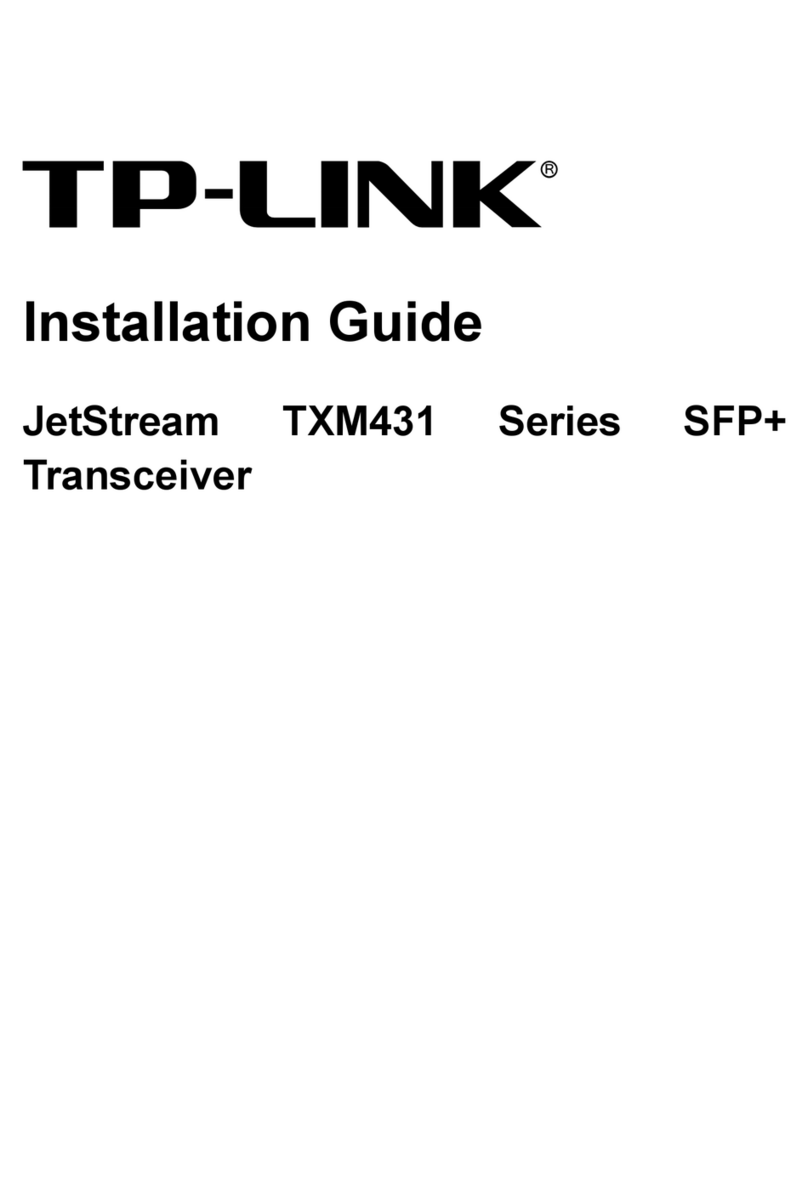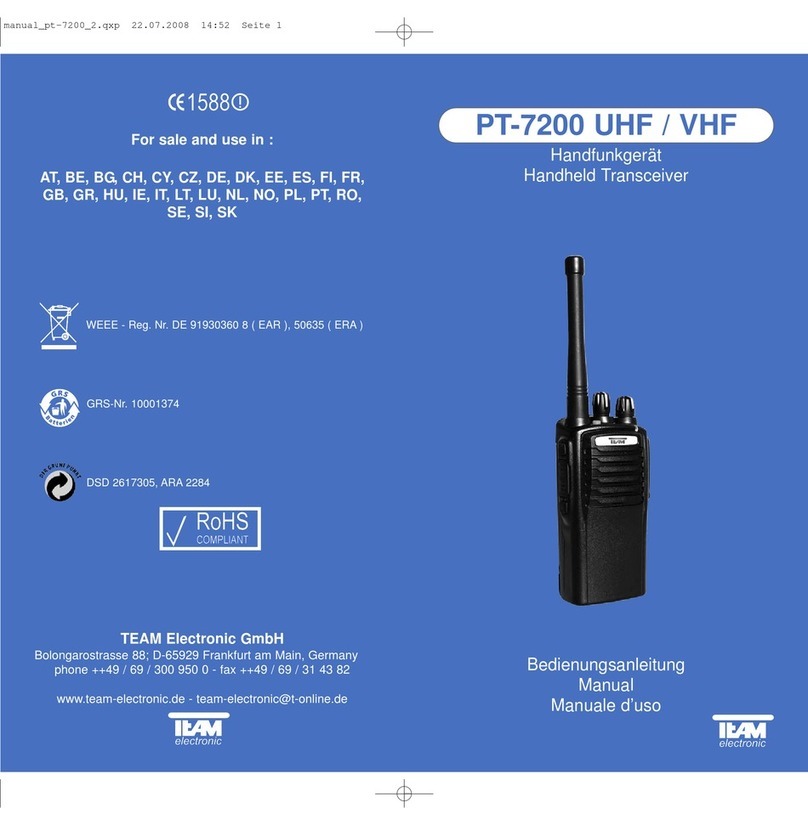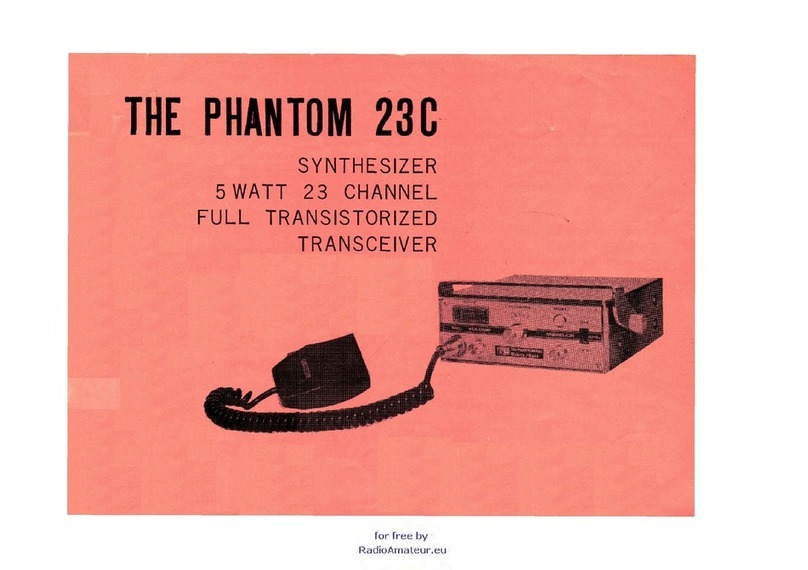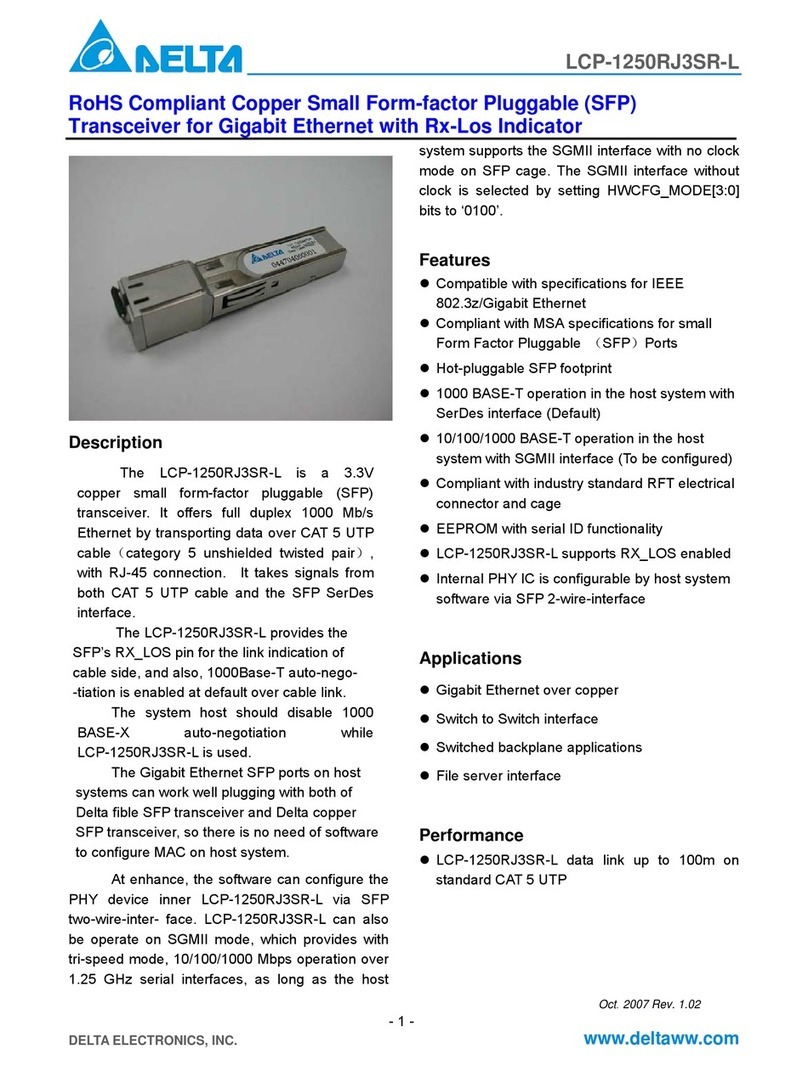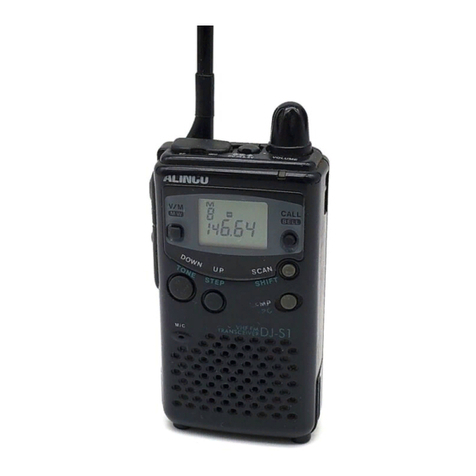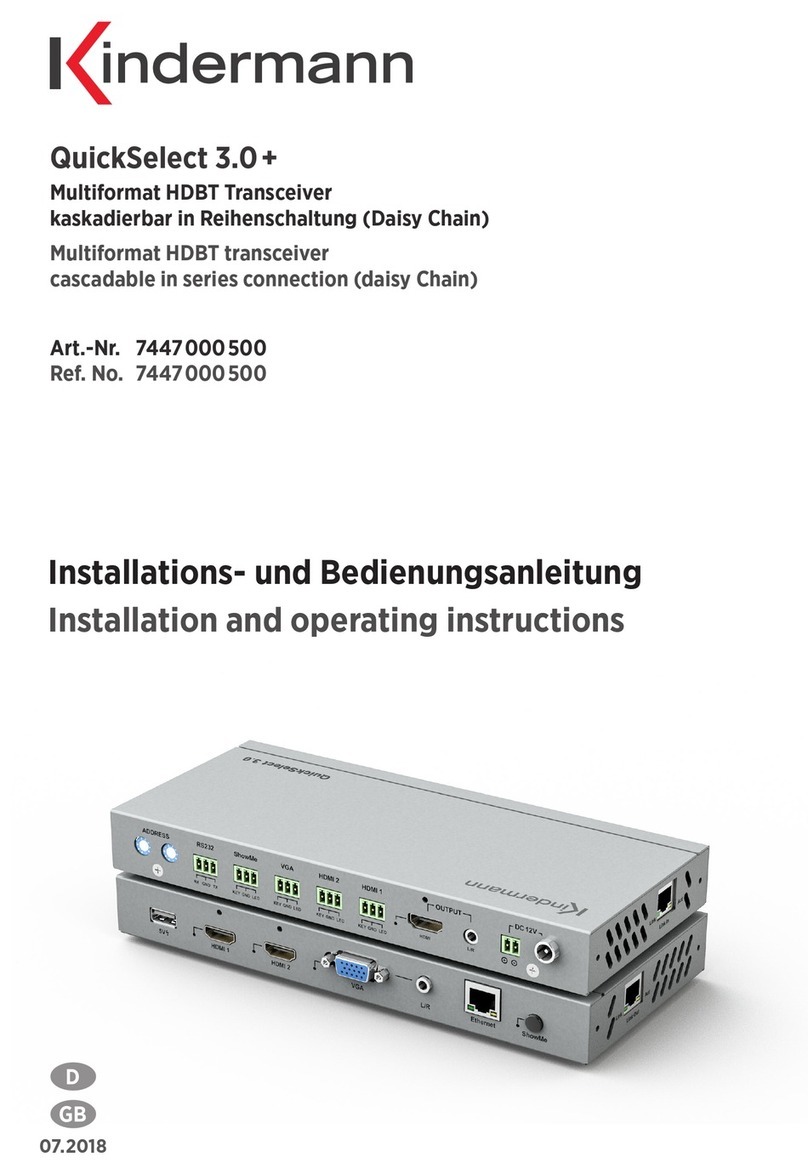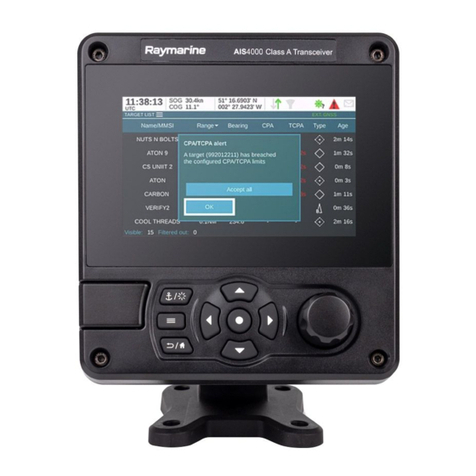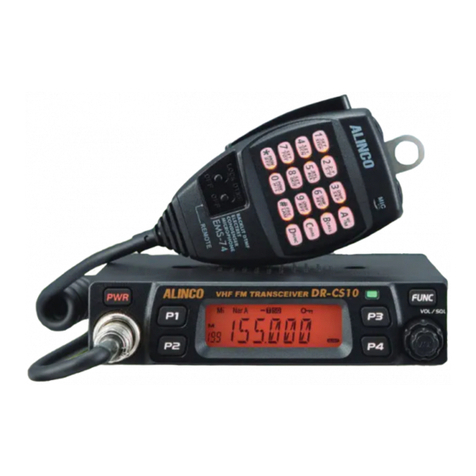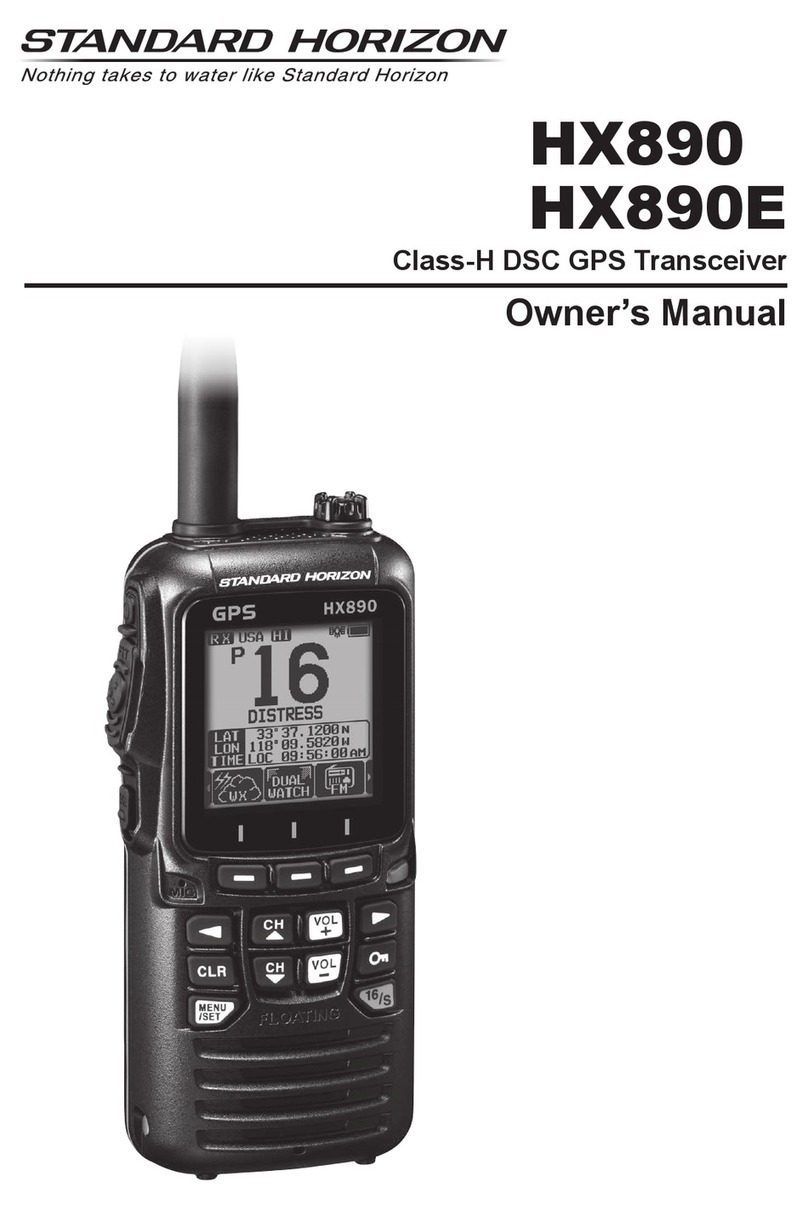Icom IC-T81A User manual

INSTRUCTION MANUAL
This device complies with Part 15 of the FCC rules. Operation is sub-
ject to the following two conditions: (1) This device may not cause
harmful interference, and (2) this device must accept any interference
received, including interference that may cause undesired operation.
iT81A/E
MULTIBAND FM TRANSCEIVER
IC-T81A/E Manual-(1) 01.12.5 6:55 PM Page A (1,1)

Versions of the IC-T81A/E which display the “CE” symbol
on the serial number seal, comply with the European har-
monised standard ETS300 684 (EMC product standard
for Commercially Available Amateur Radio Equipment).
ii
IMPORTANT
READ ALL INSTRUCTIONS carefully and com-
pletely before using the transceiver.
SAVE THIS INSTRUCTION MANUAL—This in-
struction manual contains important operating instructions for
the IC-T81A/E.
EXPLICIT DEFINITIONS
The explicit definitions below apply to this instruction manual.
CAUTIONS
RWARNING! NEVER hold the transceiver so that the
antenna is very close to, or touching exposed parts of the
body, especially the face or eyes, while transmitting. The
transceiver will perform best if the microphone is 5 to 10 cm
(2 to 4 in) away from the lips and the transceiver is vertical.
RWARNING! NEVER operate the transceiver with a
headset or other audio accessories at high volume levels.
Hearing experts advise against continuous high volume op-
eration. If you experience a ringing in your ears, reduce the
volume or discontinue use.
NEVER connect the transceiver to an AC outlet or to a
power source of more than 16 V DC. Such a connection will
damage the transceiver.
NEVER connect the transceiver to a power source that is
DC fused at more than 5 A. Accidental reverse connection will
be protected by this fuse, higher fuse values will not give any
protection against such accidents and the transceiver will be
ruined.
NEVER attempt to charge alkaline or dry cell batteries. Be-
ware that external DC power connections will charge batteries
inside the battery case. This will damage not only the battery
case but also the transceiver.
WORD DEFINITION
RWARNING Personal injury, fire hazard or electric
shock may occur.
CAUTION Equipment damage may occur.
NOTE If disregarded, inconvenience only. No risk
of personal injury, fire or electric shoc
k.
IC-T81A/E Manual-(1) 01.12.5 6:55 PM Page ii (1,1)

iii
DO NOT push the PTT when not actually desiring to trans-
mit.
Place unit in a secure place to avoid inadvertent use by chil-
dren.
DO NOT operate the transceiver near unshielded electri-
cal blasting caps or in an explosive atmosphere.
AVOID using or placing the transceiver in direct sunlight or
in areas with temperatures below –10°C (+14°F) or above
+60°C (+140°F).
The use of non-Icom battery packs/chargers may impair
transceiver performance and invalidate the warranty.
Even when the transceiver power is OFF, a slight current still
flows in the circuits. Remove the battery pack or case from
the transceiver when not using it for a long time. Otherwise,
the battery pack or installed Ni-Cd batteries will become ex-
hausted.
For USA only:
Caution: Changes or modifications to this transceiver, not ex-
pressly approved by Icom Inc., could void your authority to
operate this transceiver under FCC regulations.
SUPPLIED ACCESSORIES
Accessories included with the transceiver:
➀Battery pack (BP-199 or BP-200) . . . . . . . . . . . . . . . . . 1
➁Antenna . . . . . . . . . . . . . . . . . . . . . . . . . . . . . . . . . . . . . 1
➂Handstrap . . . . . . . . . . . . . . . . . . . . . . . . . . . . . . . . . . . 1
➃Belt clip . . . . . . . . . . . . . . . . . . . . . . . . . . . . . . . . . . . . . 1
*Some versions are supplied with a wall charger.
qwer
IC-T81A/E Manual-(1) 01.12.5 6:55 PM Page iii (1,1)

iv
IMPORTANT ................................................................................................... ii
EXPLICIT DEFINITIONS ................................................................................ ii
CAUTIONS ..................................................................................................... ii
SUPPLIED ACCESSORIES ........................................................................... iii
TABLE OF CONTENTS ................................................................................. iv
1 ACCESSORY ATTACHMENT ................................................................... 1
2 PANEL DESCRIPTION ......................................................................... 2–5
■Switches, controls, keys and connectors ............................................... 2
■Function display ..................................................................................... 4
3 BATTERY PACKS AND CHARGING ................................................... 6–8
■Battery pack charging ............................................................................ 6
■Charging precautions ............................................................................. 6
■About battery packs ............................................................................... 6
■Charging connections ............................................................................ 7
■Battery case ........................................................................................... 8
4 BASIC OPERATION ........................................................................... 9–14
■Power ON .............................................................................................. 9
■Setting a frequency ................................................................................ 9
■Setting tuning steps ............................................................................. 10
■Selecting a memory channel ................................................................ 11
■Lock function ........................................................................................ 11
■Receive and transmit ........................................................................... 11
■FM broadcast reception ....................................................................... 12
■Air band reception ................................................................................ 12
■Narrow FM operation ........................................................................... 12
■RIT/VXOa function ............................................................................... 13
■Receive mode ...................................................................................... 14
5 REPEATER OPERATION ................................................................. 15–17
■General ................................................................................................ 15
■Subaudible tones for repeater use ....................................................... 16
■Setting an offset frequency .................................................................. 16
■Auto repeater function ......................................................................... 17
6 MEMORY/CALL PROGRAMMING ................................................... 18–20
■General ................................................................................................ 18
■Programming a memory channel ......................................................... 18
TABLE OF CONTENTS
■Memory editing .................................................................................... 19
■Memory names .................................................................................... 20
7 DTMF MEMORY ..................................................................................... 21
■Programming a DTMF code ................................................................ 21
■Transmitting a DTMF code .................................................................. 21
8 SCAN FUNCTIONS .......................................................................... 22–24
■Scan types ........................................................................................... 22
■Full/programmed scan ......................................................................... 23
■Memory (skip) scan ............................................................................. 23
■Skip channel setting ............................................................................. 24
■Scan resume condition ........................................................................ 24
9 SUBAUDIBLE TONE OPERATION .................................................. 25–26
■Tone squelch ........................................................................................ 25
■Tone scan ............................................................................................ 26
■Pocket beep operation ......................................................................... 26
10 OTHER FUNCTIONS ........................................................................ 27–30
■Help function ........................................................................................ 27
■Initial set mode ..................................................................................... 27
■Resetting the CPU ............................................................................... 29
■Cloning ................................................................................................. 30
11 TROUBLESHOOTING ............................................................................ 31
12 SPECIFICATIONS ................................................................................... 32
13 OPTIONS ................................................................................................ 33
14 MODE ARRANGEMENT .................................................................. 34–35
15 CS-T81 CLONING SOFTWARE (OPTION) ...................................... 36–39
■Getting started ..................................................................................... 36
■System requirements ........................................................................... 36
■Software installation ............................................................................. 36
■COM port/Call sign setting ................................................................... 37
■Memory channel list description .......................................................... 37
■Edit menu ............................................................................................. 38
■DTMF autodial ..................................................................................... 38
■Common settings ................................................................................. 39
IC-T81A/E Manual-(1) 01.12.5 6:55 PM Page iv (1,1)

1
1
ACCESSORY ATTACHMENT
DAntenna
Screw the supplied antenna onto the
antenna connector as shown in the dia-
gram below.
Keep the jack cover attached when
jacks are not in use to avoid bad con-
tacts.
DHandstrap
Attach the handstrap to the belt clip, be-
fore attaching the belt clip to the trans-
ceiver, as below.
DBelt clip
Attach the belt clip to the transceiver as
illustrated below.
uCAUTION:
Transmitting
without the an-
tenna may dam-
age the
transceiver.
IC-T81A/E Manual-(1) 01.12.5 6:55 PM Page 1 (1,1)

PANEL DESCRIPTION
2
2
q[MULTI]
w[SQL]
e[TX/RX]
r[PTT]
t[PWR]
y
u[SP/MIC]
i[DIAL]
o[VFO]
!0 [MR]
!1 [CALL]
!2 [H/L]
!3 [RIT] !6 [DC13.5V]!5 [M]
!4
Function
display
Speaker/
Microphone
qMULTIFUNCTION SWITCH [MULTI]
➥Push to select the tone or duplex menu. (pgs. 15–17);
push for 1 sec. to enter set mode (p. 35).
➥Push ↕to increase/decrease the volume (p. 11).
➥Push ↔to change the operating band; push for 1 sec.
to start a scan (p. 22).
wSQUELCH SWITCH [SQL] (p. 11)
➥Push and hold to open the squelch.
➥While pushing, rotate [DIAL] to adjust the squelch set-
ting.
eTX/RX INDICATOR (p. 11)
Lights red while transmitting; green while receiving (or
when the squelch is open).
rPTT SWITCH [PTT] (p. 11)
Push and hold to transmit; release to receive.
tPOWER SWITCH [PWR] (p. 9)
Push for 1 sec. to turn power on and off.
yANTENNA CONNECTOR (p. 1)
Connects the supplied antenna.
uEXTERNAL SPEAKER AND MICROPHONE JACKS
[SP/MIC]
Connect an optional speaker-microphone or headset, if de-
sired. The internal microphone and speaker will not func-
tion when either is connected. (See p. 33 for options.)
■Switches, controls, keys and connectors
NOTE: In this manual—
Push [MULTI] means push ñdirectly;
Push [MULTI(↕)] means push ñup or down; and
Push [MULTI(↔)] means push ñleft or right. See q
IC-T81A/E Manual-(1) 01.12.5 6:55 PM Page 2 (1,1)

3
2
PANEL DESCRIPTION
☞NOTE: When connecting or disconnecting an external
speaker-microphone, first turn off power to the transceiver.
iTUNING CONTROL [DIAL]
Changes the operating frequency; memory channel in
memory mode; set mode contents in set mode, etc.
oVFO/CLEAR KEY [VFO(CLR/MHz)Å]
➥Push to select VFO mode. (p. 9)
➥Cancels some functions such as digit input before entry,
scans, etc.
➥Push and hold for 1 sec., then rotate [DIAL] to change
the MHz digit. (p. 10)
➥While pushing [PTT], this key sends a DTMF “A.”(p. 21)
!0 MEMORY MODE KEY [MR(MW)ı]
➥Push to select memory mode. (p. 11)
•“X”appears while in memory mode.
➥Push for 1 sec. to enter memory write mode. (p. 18)
➥While pushing [PTT], this key sends a DTMF “B.”(p. 21)
!1 CALL KEY [CALLÇ]
➥Push to select the call channel. (p. 19)
➥While pushing [PTT], this key sends a DTMF “C.”(p. 21)
This connection
does not apply
when a conden-
sor microphone
is connected.
Remote Audio out
(8 Ω)
[SP]
MIC
3.2 V
PTT
[MIC] Audio input
PTT
33 kΩ
(2 kΩ)
!2 OUTPUT POWER KEY [H/L(LOCK)Î]
➥Push to toggle between low and high power. (p. 11)
•“LOW”appears while low power is selected.
➥Push for 1 sec. to toggle the lock function on/off. (p. 11)
•“L”appears while the lock function is activated.
➥While pushing [PTT], this key sends a DTMF “D.”(p. 21)
!3 RIT KEY [RIT(TSCAN)#] (p. 13)
➥Push, then rotate [DIAL] to change the RIT/VXO setting.
•This function is only available for the 1.2 GHz band and RIT
or VXO must be activated in set mode (p. 13).
➥Push for 1 sec. to turn the tone scan function on/off. (p.
26)
➥While pushing [PTT], this key sends a DTMF “F.”(p. 21)
!4 DIGIT KEYS
➥Input the specified digit during frequency input, memory
channel selection, etc.
➥Transmit the DTMF code of the specified digit while
pushing [PTT]. (p. 21)
!5 MHz KEY [•(M)]
➥Used as a shortcut for inputting frequencies. (p. 10)
➥Transmits an “E”for DTMF operation while pushing
[PTT]. (p. 21)
!6 EXTERNAL DC POWER JACK [DC13.5V]
Allows you to operate the transceiver with a 4.5 to 16 V DC
power source using optional cables, CP-12L or OPC-254L.
uCAUTION: DO NOT connect when a battery case is at-
tached.
IC-T81A/E Manual-(1) 01.12.5 6:55 PM Page 3 (1,1)

4
2PANEL DESCRIPTION
■Function display
T SQL SKIP
MR
DUPFMW
VOL LOW
15
9
AM
q
we r t
y
u
i!0!1 o
IC-T81A/E Manual-(1) 01.12.5 6:55 PM Page 4 (1,1)

5
2
PANEL DESCRIPTION
qFREQUENCY INDICATION
Shows the selected frequency, set mode contents, etc.
wMODE INDICATORS
Indicate the operating mode.
eDUPLEX INDICATOR (p. 15)
Appears during semi-duplex operation.
•“–DUP”appears for minus duplex; “DUP”appears for plus du-
plex.
rTONE INDICATORS
“T”appears when the subaudible tone encoder (p. 15) is in
use; “T SQLS”appears during pocket beep operation
(p. 26) and “T SQL”appears when the tone squelch func-
tion (p. 25) is activated.
tSKIP INDICATOR (p. 23)
Appears when the selected channel is set as a “skip”chan-
nel.
yMEMORY MODE INDICATOR (p. 11)
Appears while in memory mode.
uMEMORY CHANNEL INDICATOR
Indicates the selected memory channel and other items
such as the call channel, set mode items, etc.
iS/RF INDICATORS (p. 11)
Show the relative signal strength while receiving and the
output power selection while transmitting.
oRIT/VXO INDICATOR (p. 13)
Appears when either the RIT or VXO function is activated
and the 1.2 GHz band is selected.
!0 LOW POWER INDICATOR (p. 11)
Appears when low output power is set.
!1 VOLUME INDICATOR
Appears while adjusting the volume.
•Indicators also appear in place of the operating frequency while
adjusting volume to visually indicate the selected volume level.
IC-T81A/E Manual-(1) 01.12.5 6:55 PM Page 5 (1,1)

6
3BATTERY PACKS AND CHARGING
■Battery pack charging
The supplied* BP-198, BP-199 or BP-200
BATTERY PACK
in-
cludes rechargeable Ni-MH batteries and can be charged ap-
prox. 300 times. Charge the battery pack before first
operating the transceiver or when the battery pack becomes
exhausted.
*Optional for versions which come with the BP-197
BATTERY CASE
.
If you want to get the longest life out of your battery pack
(300+ charges), the following points should be observed:
1. Avoid overcharging. The charging period should be less
than 15 hours.
2. Use the battery until it becomes completely exhausted
under normal conditions. We recommend battery charging
just after transmitting becomes impossible.
■Charging precautions
NEVER attempt to charge alkaline batteries. This will cause
internal liquid leakage and damage the battery case and
transceiver.
NEVER connect two or more chargers at the same time.
Charging may not occur under temperatures of 10°C (50°F)
or over temperatures of 40°C (104°F).
■About battery packs
DOperating period
Depending on attached battery pack, the operating period of
the transceiver varies. When the approx. voltage of battery
packs BP-198, BP-199 or BP-200 falls to 4, 5 or 8 V, respec-
tively, charging is necessary. Refer to p. 33 for operating pe-
riod details.
DBattery life
If your battery pack seems to have no capacity even after
being fully charged, completely discharge it by leaving the
power ON overnight. Then fully charge the battery pack
again.
If the battery pack still does not retain a charge (or very little),
a new battery pack must be purchased.
☞NOTE: When using a battery pack for the first time or after
long periods of inactivity between charges (approx. 2
months or more), the battery pack will not be able to retain
a full charge immediately. Subsequent charge/discharge
cycles will eventually bring the battery pack up to full
charge capacity.
IC-T81A/E Manual-(1) 01.12.5 6:55 PM Page 6 (1,1)

7
3
BATTERY PACKS AND CHARGING
■Charging connections
DRegular charging
Attach the sup-
plied or optional
battery pack;
then, connect the
supplied* wall
charger via an AC
outlet as shown at
right.
*Optional for ver-
sions which include
a battery case.
DRapid charging with the BC-119
➀Fix the optional AD-88
TERMINAL PC BOARD FOR CHARGER
into the BC-119 with the 4 supplied screws.
➁Insert the optional AD-87A
CHARGE ADAPTER
into the charg-
ing slot of the BC-119.
➂Insert the optional AD-87B
CHARGE ADAPTER
into AD-87A
(check orientation).
➃Insert the battery pack, either by itself or attached to the
transceiver, into the whole assembly for charging (see
right).
To
[DC13.5V]
Wall charger
AD-87B
(optional)
AD-88
(optional)
Check orientation
for correct charging
AD-87A
(optional)
BC-119
(optional)
Charging period:
15 hours
Charging periods: 1 hour (w/BP-198 or BP-199)
1.5 hours (w/BP-200)
IC-T81A/E Manual-(1) 01.12.5 6:55 PM Page 7 (1,1)

8
3BATTERY PACKS AND CHARGING
DOperation with an optional cable
Connect an optional charger or cable to the transceiver as il-
lustrated below. Be careful of battery overcharging as the
connected battery is charged simultaneously.
uCAUTION: When the BP-197
BATTERY CASE
is con-
nected, charging cannot take place.
Wall charger
OPC-254L
(optional)
To
[DC13.5V]
black
white
CP-12L
(optional)
*To charge the battery pack
13 to 16 V DC is necessary.
■Battery case
When using a battery case attached to the transceiver, install
3 AA(R6) size alkaline batteries as illustrated below.
Remove the case from the
transceiver.
Install 3 AA(R6) size alkaline
batteries into the battery case.
Open the case.
IC-T81A/E Manual-(1) 01.12.5 6:55 PM Page 8 (1,1)

9
4
BASIC OPERATION
■Power ON
☞NOTE: Charge the battery pack before turning power on
for the first time (pgs. 6–8)
Push and hold [PWR] for 1 sec. to turn power on.
•Current battery voltage may be dis-
played for 2 sec.
•The display shows the approx. volt-
age in 0.5 V steps.
•If “OVER V”appears, UNPLUG the
external DC plug immediately. Con-
nected voltage is over 16 V and could
damage the transceiver.
■Setting a frequency
DVia the keypad
(from the MHz digits)
➀Push [VFO] to select VFO
mode.
➁Push digit keys correspond-
ing to the desired frequency.
•When inputting a frequency in
the 50 or 1200 MHz bands, it
is necessary to input the deci-
mal point.
•When a digit is mistakenly
input, push [VFO] and input
from the beginning.
•When an unacceptable fre-
quency is input, the display re-
verts to the previously
displayed frequency.
•“0,”“2,”“5”and “7”are accept-
able as the 1 kHz digit input
depending on the 10 kHz digit.
for 1 sec.
after
PWR
2 sec.
.
5
5
8
7
2
[Example]
IC-T81A/E Manual-(1) 01.12.5 6:55 PM Page 9 (1,1)

■
Setting tuning steps
The transceiver has 9 tuning steps* (each band has indepen-
dent settings) as follows:
5 kHz 10 kHz 12.5 kHz 15 kHz 20 kHz
25 kHz 30 kHz 50 kHz 100 kHz
*The 5 and 15 kHz steps are not available on the 1200 MHz band.
➀Push [VFO] to select VFO mode.
➁Push [MULTI(↔)] to select the desired band.
➂Push [MULTI] for 1 sec. to enter set mode.
➃Push [MULTI(↕)] one or more times
until “TS”appears.
➄Push [MULTI(↔)] (or rotate [DIAL])
to select the desired tuning step.
➅Push [VFO] to exit set mode.
✔CONVENIENT
Select a tuning step that matches the frequency intervals of
repeaters in your area.
10
4BASIC OPERATION
DVia the keypad
(from the decimal point)
➀Push [VFO] to select VFO
mode.
➁Push [•] to leave the MHz
setting as is and input from
the kHz digits.
DOther methods
➥Via the [DIAL]: Rotate [DIAL] to change the frequency ac-
cording to the set tuning steps.
➥Via the MHz STEP: Push [(VFO)MHz] for 1 sec., then ro-
tate [DIAL] to change the frequency in 1 MHz steps.
USING
SET MODE
5
8
0
.
[Example]
15 kHz tuning step
25 kHz tuning step
IC-T81A/E Manual-(1) 01.12.5 6:55 PM Page 10 (1,1)

11
4
BASIC OPERATION
■Selecting a memory channel
➀Push [MR] to select mem-
ory mode.
➁Push [MULTI(↔)] (or rotate
[DIAL] or push digit keys) to
select the desired memory
channel.
•Only programmed memory
channels can be selected.
•Memory channels 1–9 are
preceded with a “0”when se-
lecting with the digit keys;
push “0@”to select scan edge
0A, push “0?”to select scan
edge 0B.
■Lock function
Push [(H/L)LOCK] for 1 sec. to toggle
the lock function on and off.
•“L”appears while the lock function is ac-
tivated.
•[PTT], [PWR], [MULTI(↕)] (volume), [SQL] and [H/L] can be used
even when the lock function is activated.
■Receive and transmit
➀Push [PWR] for 1 sec. to turn power on.
➁Push [MULTI(↕)] to set a volume level.
➂Set the squelch level.
•While pushing [SQL], rotate [DIAL].
•10 selections are available, “OPEN,”
“AUTO,”and “SQL 1 to “SQL 8.”
➃Set an operating band and frequency.
•When a signal is received:
➟Squelch opens and audio is emitted from the speaker.
➟The [TX/RX] indicator lights green.
➄Push [H/L] to toggle output power between high and low.
•“LOW”appears when low output power is selected.
➅Push and hold [PTT] to transmit; then speak into the mic.
•Do not hold the microphone too close to your mouth or speak
too loudly. This may distort the signal.
•The S/RF indicator shows the output power selection.
•The [TX/RX] indicator lights red.
➆Release [PTT] to return to receive.
✔CONVENIENT
Monitor function: Push and hold [SQL] to listen to weak sig-
nals that do not open the squelch.
MR
9
9
MR
MR
MR
IC-T81A/E Manual-(1) 01.12.5 6:55 PM Page 11 (1,1)

12
4BASIC OPERATION
■FM broadcast reception
The transceiver can receive FM radio broadcasts. These are
typically in the range 76–107.995 MHz (88–107.995 for some
versions) and are in WFM receive mode.
To select the FM broadcast band:
➥Push [MULTI(↔)] one or more
times until “WFM”appears in the
display, then rotate [DIAL] to select
a frequency; or,
➥Select a frequency with the digit keys directly.
•“WFM”automatically appears when a frequency in the range
76–107.995 MHz is input.
☞NOTE: When pushing [PTT], “OFF”appears indicating the
frequency and mode are outside the permitted range.
■Air band reception (Asia, USA ver.)
The transceiver can receive frequencies reserved for com-
mercial/private aircraft and ground support. These are in the
range 118–135.995 MHz and are in AM receive mode.
To select the air band:
➥Push [MULTI(↔)] one or more
times until “AM”appears in the dis-
FMW
play, then rotate [DIAL] to select a frequency; or,
➥Select a frequency with the digit keys directly.
•“AM”automatically appears when a frequency in the range
118–135.995 MHz is input.
☞NOTE: When pushing [PTT], “OFF”appears indicating the
frequency and mode are outside the permitted range.
■Narrow FM*
operation (Europe, France, Italy ver.)
➀Push [MULTI(↔)] one or more
times to select the 144 MHz band.
➁Push [MULTI] for 1 sec. to enter set
mode.
➂Push [MULTI(↕)] one or more times
to display “MO,”if necessary.
➃Push [MULTI(↔)] (or [DIAL]) to tog-
gle narrow FM operation on and
off.
•“FM”appears when narrow FM
operation is on.
➄Push [VFO] to exit set mode and return to regular opera-
tion.
☞*NOTE: FM narrow operation can be set for individual
memory channels or in VFO mode; narrow FM affects
AM
USING
SET MODE
FM
Narrow FM is on.
Narrow FM is off.
IC-T81A/E Manual-(1) 01.12.5 6:55 PM Page 12 (1,1)

13
4
BASIC OPERATION
■RIT/VXO function (1200 MHz band)
In the 1200 MHz band, differences between actual and dis-
played frequencies can often be large. The RIT (receive in-
cremental tuning) function allows you to compensate the
displayed frequency for differences in the actual receive fre-
quency; the VXO (variable crystal oscillator) function allows
you to compensate the displayed frequency for differences in
the actual receive and transmit frequencies.
DActivating RIT/VXO
➀Select a frequency in the 1200 MHz band (or a memory
channel with a 1200 MHz band frequency; or the 1200
MHz band call channel).
➁Push [MULTI] for 1 sec. to enter set mode.
➂Push [MULTI(↕)] one or more times until “rV”appears.
➃Push [MULTI(↔)] one or more
times to select “RIT”(RIT activated,
“VXO”(VXO activated) or “OFF”
(neither activated)—[DIAL] can
also be used.
➄Push [VFO] to exit set mode and
return to the previously selected
mode.
•When RIT or VXO is activated, “:”ap-
pears above the decimal point in the
frequency indication (in the 1200 MHz band).
USING
SET MODE
DAdjusting the frequency with RIT/VXO
Make sure that RIT or VXO is activated in set mode and that
the 1200 MHz band is selected.
➀Select a frequency in the 1200 MHz band (or a memory
channel with a 1200 MHz band frequency; or the 1200
MHz band call channel).
➁Push [RIT] to display the frequency
offset in kHz.
➂Push [MULTI(↔)] one or more
times (or rotate [DIAL]) to adjust
the frequency offset.
•The frequency offset can be set
±5 kHz in 1 kHz steps.
➃Push [VFO] to return to regular dis-
play indication.
☞NOTE: When using the RIT/VXO function the indicated off-
set frequencies are only approximate values.
Offset: –2 kHz
(approx.)
Offset: +5 kHz
(approx.)
IC-T81A/E Manual-(1) 01.12.5 6:55 PM Page 13 (1,1)

14
4BASIC OPERATION
■Receive mode
The IC-T81A/E allows you to receive frequencies in the 50
MHz band in AM mode (as well as to transmit in FM narrow
mode in the 144 MHz band for Italy, France and Europe ver-
sions only—see p. 12).
➀Push [VFO] to select VFO mode.
➁Push [MULTI(↔)] one or more
times to select the 50 MHz band.
➂Push [MULTI] for 1 sec. to enter set
mode.
➃Push [MULTI(↕)] one or more times
until “MO”appears.
➄Push [MULTI(↔)] (or rotate [DIAL])
one or more times to select “AM.”
➅Push [VFO] to exit set mode and return to VFO mode.
•“AM”appears when frequencies in the 50 MHz band are se-
lected.
☞NOTE:
➥When AM operation is selected, transmit is not possible.
When [PTT] is pushed, “OFF”appears.
➥AM operation can also be selected for individual mem-
ory channels programmed with 50 MHz frequencies. In
this way you can program individual frequencies for AM
receive while allowing regular transmit/receive for 50
MHz frequencies in VFO mode.
USING
SET MODE
AM
IC-T81A/E Manual-(1) 01.12.5 6:55 PM Page 14 (1,1)

15
5
REPEATER OPERATION
■General
When using a repeater, the transmit frequency is shifted from
the receive frequency by the offset frequency. It is convenient
to program repeater info into memory channels (pgs. 18–20).
➀Set the operating band and receive frequency (repeater
output frequency).
➁Push [MULTI] to enter duplex set mode.
•“D”appears; if “T”appears instead of “D”push [MULTI(↕)] to se-
lect “D.”
➂Push [MULTI(↔)] (or rotate [DIAL]) one or more times to
select DUP ( plus duplex) or –DUP (minus duplex).
•When the auto repeater function is in use (USA version only)
steps ➁, ➂, ➃and ➄are not necessary (p. 17).
➃Push [MULTI(↕)] to select tone set mode.
•“T”appears.
➄Push [MULTI(↔)] (or rotate [DIAL]) to activate the sub-
audible tone encoder according to repeater requirements.
•Refer to the table of subaudible tone frequencies on the following
page.
➅Push and hold [PTT] to transmit.
•The displayed frequency automatically changes to the transmit
frequency (repeater input frequency).
•If “OFF”appears, check the offset frequency (p. 16).
➆Release [PTT] to receive.
➇Push and hold [SQL] to check whether the other station’s
transmit signal can be directly received or not.
DTone information
Some repeaters require a tone to be accessed. In this case,
precede step ➅at left with the required tone.
DTMF TONES
While pushing [PTT], push the desired digit key(s) to transmit
DTMF tones.
•The transceiver has 9 DTMF memory channels. See p. 21 for de-
tails.
1750 Hz TONE
While pushing [PTT], push and hold [MULTI] for 1 to 2 sec.
to transmit a 1750 Hz tone signal.
✔Convenient
Tone scan function: When you don’t know the subaudible
tone used for a repeater, the tone scan is convenient for de-
tecting the tone frequency.
Push [(RIT)TSCAN)] for 1 sec. to activate the tone scan. See
p. 26 for more details.
IC-T81A/E Manual-(1) 01.12.5 6:55 PM Page 15 (1,1)

16
5REPEATER OPERATION
■Subaudible tones
for repeater use
Some repeaters require subaudible tones to be accessed.
Subaudible tones are superimposed over your normal signal
and must be set in advance.
➀Push [VFO] to select VFO mode.
➁Push [MULTI(↔)] to select a band.
➂Push [MULTI] for 1 sec. to enter set
mode.
➃Push [MULTI(↕)] one or more times
until “rT”appears.
➄Push [MULTI(↔)] (or rotate (DIAL)
to select the desired subaudible
tone.
➅Push [VFO] to enter the selected tone and exit set mode.
Available subaudible tone frequencies (unit: Hz)
67.0 79.7 94.8 110.9 131.8 156.7 171.3 186.2 203.5 229.1
69.3 82.5 97.4 114.8 136.5 159.8 173.8 189.9 206.5 233.6
71.9 85.4 100.0 118.8 141.3 162.2 177.3 192.8 210.7 241.8
74.4 88.5 103.5 123.0 146.2 165.5 179.9 196.6 218.1 250.3
77.0 91.5 107.2 127.3 151.4 167.9 183.5 199.5 225.7 254.1
USING
SET MODE
T
T
■Setting an offset
frequency
When communicating through a repeater, the transmit fre-
quency is shifted from the receive frequency by an amount
determined by the offset frequency.
➀Push [VFO] to select VFO mode.
➁Push [MULTI(↔)] to select a band.
➂Push [MULTI] for 1 sec. to enter set
mode.
➃Push [MULTI(↕)] one or more times
until “OW”appears.
➄Push [MULTI(↔)] (or rotate (DIAL)
to select the desired offset.
•The offset frequency changes according to the selected tuning
steps.
•The MHz step may be helpful for large frequency changes—push
[(VFO)MHz] for 1 sec.
➅Push [VFO] to enter the selected offset and exit set mode.
USING
SET MODE
DUP
DUP
IC-T81A/E Manual-(1) 01.12.5 6:55 PM Page 16 (1,1)
This manual suits for next models
4
Table of contents
Other Icom Transceiver manuals
